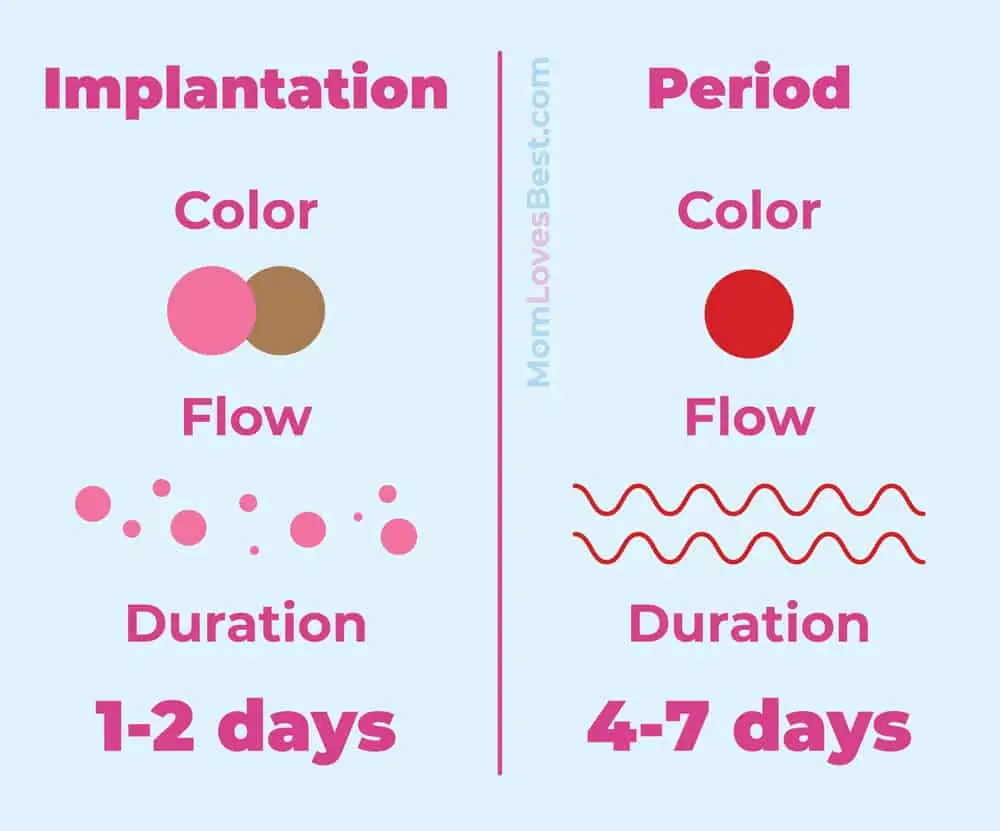Are you trying to get pregnant and have noticed a change in your bleeding? Are you trying to determine whether it’s an early sign of pregnancy or your period starting?
Every hopeful mom is eager to see the first sign of a new life growing, so it’s hard not to panic when our bodies behave unexpectedly.
Our medical team consists of moms who have been through these experiences. We understand the anxiety when trying to conceive and know how we tend to look at every change within our bodies as a sign of potential pregnancy.
We’ll help you recognize the difference between a period and implantation bleeding. We’ll explain common misconceptions around implantation bleeding. And we’ll let you know how long implantation bleeding should last, what it should look like, and when you should be concerned.
Key Takeaways
- Implantation bleeding is light spotting during early pregnancy when a fertilized egg attaches to the uterus lining, occurring in about 30% of pregnant women.
- Implantation bleeding is typically lighter, shorter, and a different color than period blood, lasting no more than three days.
- Heavy implantation bleeding could be a sign of an ectopic pregnancy or other complications, and should be reported to a doctor immediately.
- To ensure safety during pregnancy, avoid using tampons if you suspect implantation bleeding, as they can introduce harmful bacteria.
- Is Implantation Blood Normal During Pregnancy?
- What is Implantation Bleeding?
- When Does Implantation Bleeding Occur?
- Does Every Woman Experience Implantation Bleeding?
- What Does Implantation Bleeding Look Like?
- How Common is Heavy Implantation Bleeding?
- How Common is Late Implantation Bleeding?
- Does Heavy Implantation Bleeding Mean Twins?
- Is Implantation Bleeding a Miscarriage Sign?
- Can Implantation Bleeding Include Clots?
- Other Symptoms of Implantation Bleeding
- Are Tampons Okay During Implantation Bleeding?
- Implantation Bleeding FAQs
Is Implantation Blood Normal During Pregnancy?
As women, we have a pretty familiar relationship with blood, especially if it comes from down there. It’s just part of life, and after a while, it stops being gross and scary and just becomes routine.
But there are many reasons why we may see blood besides a period. From irritation to breastfeeding to hormonal changes, our bodies can expel blood for a variety of reasons. One of these reasons is implantation bleeding during early pregnancy, and it’s perfectly normal!
What is Implantation Bleeding?
Light spotting during early pregnancy is usually the sign that the fertilized egg has lodged itself into the uterus lining. As the egg moves down your fallopian tubes and into your womb, it nestles into the uterine lining, nice and snug. But this can cause enough irritation to produce light, harmless bleeding.
When Does Implantation Bleeding Occur?
Contrary to popular belief, this form of bleeding doesn’t happen right when implantation takes palce. It’s a a sign it has happened, not that it’s currently happening.
You shouldn’t expect to see implantation bleeding until the deed is done. Bleeding won’t happen until at least five days after conception, but it can take up to ten days to notice any bleeding — if it happens at all (1). In some cases, this coincides with the typical time of a woman’s period, and she may not realize she is pregnant at all.
Does Every Woman Experience Implantation Bleeding?
Only around 30% of pregnant women experience implantation bleeding.
If you don’t see any spotting in your early pregnancy, don’t freak out — you’re in the majority. Even if you did bleed a tiny amount, you may have missed it.
Relying on one clue to prove your pregnancy is never a good idea, so if you think you may be pregnant but haven’t noticed spotting, look for more signs.
What Does Implantation Bleeding Look Like?
Many women get confused when they try to figure out if what they’re seeing is a sign of pregnancy or just the beginning of their period. They may also wonder if something is wrong, especially if they hadn’t planned on a pregnancy.
It’s pretty simple to decipher period bleeding from implantation bleeding if you understand your cycle well and know what to look for. Picture what a typical period looks like for you, and compare it to what you’re seeing.
These are some of the things you’ll notice with implantation bleeding:
- Amount: Implantation bleeding is nowhere near as heavy as a period. It shouldn’t be enough to fill a pad. If it’s less than what you’d see during a period, this is a great clue.
- Color: Every woman sees a different pattern with her cycle, but you should be familiar with what shade your period blood usually is. Implantation bleeding is almost always a different color than period blood — sometimes dark brown, other times almost pinkish.
- Thickness: Even women who experience a light flow can usually see a difference between implantation bleeding and period blood. Unlike what you see once a month, this type of bleeding is thinner and won’t come out in thick clumps. It generally shows up as streaks or slight drops.
- Duration: The length of implantation bleeding differs between women, but the maximum amount is about three days of spotting. This is much shorter than a period, so if you see blood for a short time and it disappears, this is a good sign you’re pregnant and experiencing implantation bleeding.
- Timing: Implantation bleeding generally comes a couple of days before you expect to get your period. If you experience light bleeding and it comes before your expected period, this is a good sign that it is implantation bleeding and not your period.
Don’t stress yet if it seems what you’re seeing fits all four of these categoriescited. You should never accept anything as definite until a doctor tests you. However, it doesn’t hurt to keep paying attention to your body.
How Common is Heavy Implantation Bleeding?
Implantation bleeding is not all that common, and heavy implantation bleeding is even less so. There is minimal information about heavy or late bleeding that isn’t a period or a miscarriage. While a few success stories are buried in various mommy forums and comment sections, heavy bleeding is usually not a good sign.
Heavy implantation bleeding occurs mainly because of something wrong with the initial implantation. If this happens, it may be that the egg has planted itself somewhere it shouldn’t have, such as the cervix, fallopian tube, or abdomen.
This condition is called an ectopic pregnancy, meaning the egg is trying to grow somewhere it can’t (2). Unfortunately, these pregnancies almost always end in miscarriage and may be life-threatening to you, so seek help immediately if you experience heavy implantation bleeding and you’re sure it isn’t your period.
How Common is Late Implantation Bleeding?
Implantation occurs after fertilization. It takes the fertilized egg time to move from the fallopian tubes into the uterus. There are usually around 6 to 14 days between conception and the fertilized egg being fully implanted into the uterus.
You could see implantation bleeding the fifth or sixth day after conception, but it can occur so late it coincides with your period due date.
Late implantation bleeding can be an alarming sight, and it feels disappointing if you’re trying to conceive. But it doesn’t always indicate a miscarriage or the absence of a pregnancy. Some women have positive pregnancy tests after experiencing what they thought was their “period” because what they actually experienced was late implantation bleeding.
In some cases, implantation happens later. Studies have shown that the later the implantation, the more likely a miscarriage will occur (3). This is not written in stone, but if you’re worried, talk to your doctor.
Does Heavy Implantation Bleeding Mean Twins?
Once again, there isn’t much reliable information about the connection between twins and heavy implantation bleeding. When you’re pregnant with twins, most signs of pregnancy are exaggerated. Some women have reported seeing more spotting for longer periods in their twin pregnancies.
But truthfully, these occurrences are rare on their own and even more unlikely to happen all at once. The body is put under more stress with twins, so you may be more likely to see implantation bleeding. But many women experience implantation bleeding and go on to have singleton pregnancies.
Implantation bleeding is caused by damage to tiny blood vessels in the uterine lining, so it stands to reason if there are two eggs (like in a fraternal twin pregnancy), there would be twice as much bleeding. However, this explanation makes less sense for identical twins, and anecdotal evidence aside, there’s not much to say that implantation bleeding alone is a sign of multiples.
Keep Your Doctor In The Loop
Is Implantation Bleeding a Miscarriage Sign?
It’s easy to tend to cling to an unusual sign or symptom as proof something negative is happening, especially if you’ve had negative fertility experiences in the past. It’s also hard to see an unexplained change and stay positive, especially if your hopes are high.
But more often than not, light implantation bleeding is not a cause for concern. You can take it as a reassuring pat on the back!
Though miscarriages begin with spotting that may seem like implantation bleeding, they quickly become crampy, clotty, heavier, and thicker. You won’t see thin blood for long if you’re experiencing a miscarriage, so your worries should be put to bed after 24 hours of slight spotting.
Can Implantation Bleeding Include Clots?
Unlike period blood, implantation bleeding is very light and thin and doesn’t last long. Blood clots happen when a lot of blood pools in the bottom of the uterus and can’t be expelled through typical contractions (aka our lovely friend: cramps). There will not be enough blood to pool and thicken if you’re experiencing implantation bleeding, so this should never occur.
Let your doctor know if you see blood clots when everything else signals implantation bleeding. Clots can be a sign of miscarriage, especially if your bleeding is light as it would be during implantation (4).
Other Symptoms of Implantation Bleeding
Both early pregnancy and the start of your period can manifest similar symptoms, which is frustrating for an eager mom waiting to take a pregnancy test.
You know your body, so you know what’s normal, but there are a few key symptoms present during implantation bleeding.
- Light cramping: As the egg arrives at its soft, cushiony new home, your endometrium is preparing to be a gracious host for the next 9 months. This can result in implantation cramping.
- Lower back pain: This is another sign your body’s hormones are working hard to create the perfect place to grow your baby.
- Headaches: As progesterone courses through your body and your womb kicks into action, the sudden change may cause you to experience pregnancy headaches. This is normal.
- Mood swings: Your body is preparing to change drastically over the next few months, and your hormones have kicked into high gear. This can cause pregnancy mood swings, similar to PMS.
You may notice these symptoms are suspiciously similar to those of your period. To avoid disappointment, don’t rely on these symptoms alone. The best way to know for sure is to wait until you can take a pregnancy test.
Are Tampons Okay During Implantation Bleeding?
You should never use tampons if you’re pregnant.
Implantation bleeding shouldn’t be enough to warrant using a tampon anyway. You’ll be able to deal with it with little more than a thin panty liner. Typical implantation bleeding shouldn’t be enough to fill this, so if it does, you’re probably not pregnant. It’s more likely this means you’re starting your period.
Tampons can introduce bacteria into the vagina that can harm you and your baby. If you’re actively trying to become pregnant, always wait to use a tampon until you’re sure there is no chance of pregnancy.










